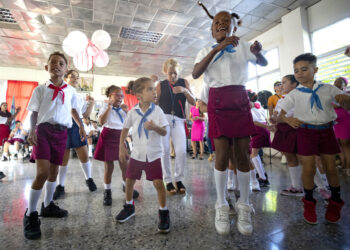Havana Compas Dance has performed, for ten years, in Cuban and part of the world scenarios. Since Liliet Rivera left the Litz Alfonso Ballet looking for aesthetic and own movements. Not always with stools or live drums. Not always with the help of Eduardo Cordova, musical director, but with the virtuosity of whom has much to add to the Cuban dance movement.
“I wanted to test me, see what I could do. Starting from scratch is a very strong challenge, I wanted to make my story, tell my story in dance and especially doing something different.
“I wanted it to be a company where you work with love, passion and fusion, but the identity of the company should be on the surface. I do not know what I would do with percussion, I just dedicated myself to train the girls in my own style, my way, and well, thanks to the fortune Eduardo Cordova came, a special envoy, because he was who led the company to take another course “.
Liliet refers that Eduardo Cordova was who incorporated her into the way of percussion, and also taught her to play drums for mixing flamenco with Yoruba and vernacular rhythms. This was, she assures, something that has differentiated the company, that has given it an own seal.
Only four girls danced in the beginning, all from other companies, and made plays with background. Drums and decorated stools, flute, bass, piano, girls with hair loose and Eduardo Cordova would come later.
” We rehearsed at Concepción Arenal student society that opened its doors for the company to have a premise; we trained these young girls you see today who started at 13 or 14. They already had a base of flamenco and wanted to risk with us, to see what do we had, our thoughts, our desire to do different art.
“I started training them, besides flamenco, in contemporary dance and Afro-Cuban dance, but I mixed all slowly, to achieve a different result in image, and I was helped a lot by Cristina Maya, unconditional collaborator of the company, and that is why they use today their hair loose, because we had to break that image of the ballerina with bun, or ponytail.
“She was who introduced me to Eduardo Cordova in 2009, for grace and fortune of the company, as he saw that it was necessary a musician, a live musician, in this case a percussionist”.
But Liliet recognizes that the musical director is not just a percussionist, but a creator, an artist, responsible for the decoration of drums and stools now used in the scene and the girls interact with the drumsticks as if the music was to enter into them to the rhythm of the strokes.
“He was he who made a percussion test to all the girls and became excited to see the talent and musical conditions they had, and began preparing them with rudiments, drumsticks control, percussion classes, and I as a choreographer began to see the possibility this provided to the company, which until then was the only one that had that link of dance with percussion.
“Playing on the stools was accidental, because there are plenty of them at Concepción Arenal student society and we used them in classes. As a choreographer I began to see in them a very personal, different hallmark, which could gradually give a positive image in the company. ”
But Havana Compas Dance has, in addition to aesthetic that distinguishes it on stage, the essence of its philosophy summarized in the name of the company, together with a commercial interest that today is no stranger to many dance companies in the country:
“Well,” Havana “because I love Havana, because it is much known internationally. I like to sell Havana with what we do. “Compas” (time) because it is precisely what the company does, it is the beat all the time, polyrhythm. “Dance” was a marketing issue, because people did not identify in the beginning if we were a dance company, a percussion band, or a musical band… Then for the problem of sealing, that people to know what was going to consume, so “Havana Compas Dance” to give it a personality as name and for people to feel it. ”
At first glance, Liliet is a passionate woman by the company that was born from her, by her desire to snatch to dance an identity with which it could go on stage to show something new, but filled with African and Spanish tradition at the time, and with as many cultural references as could fit into the blows of drumsticks and legs and palms; all at once, with their hair over their forehead and sullen look, but sensual and expert.
“I do not regret at all because even though it was a very difficult stage, I knew what I was facing up: to start from scratch, that people do not follow you because you have nothing to show, only what you have here (she says pointing with her head the stage where rehearsing) and you have to bring it to light.
“I feel great by having thought about making my own story, for my company to have a place in Cuban dance that is so prestigious and … nothing, I thank life for it.”









